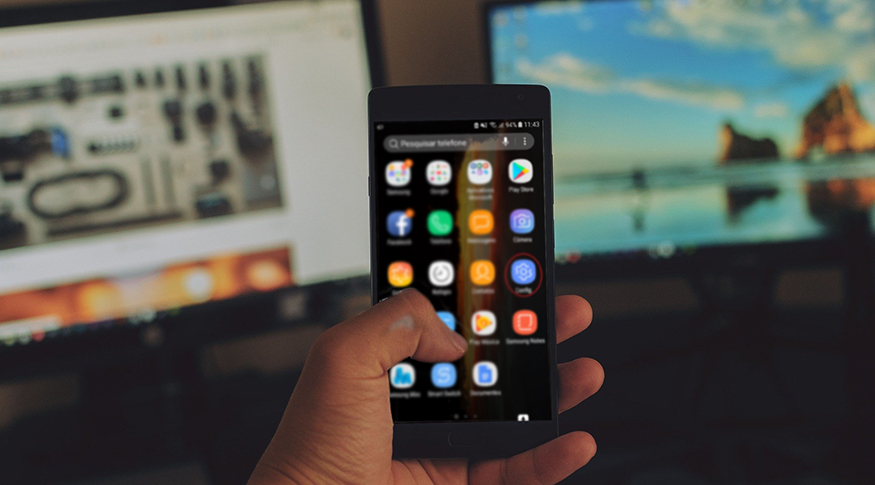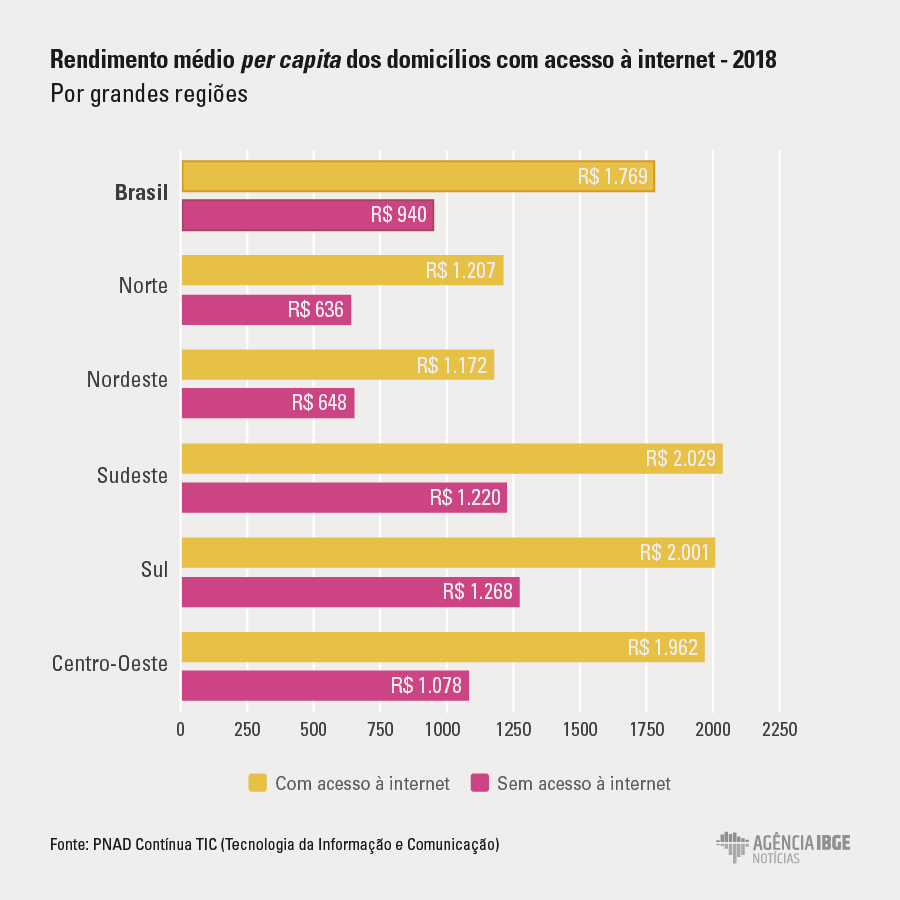PNAD TIC
Income affects population access to technological goods and the Internet
April 29, 2020 10h00 AM | Last Updated: April 30, 2020 05h54 PM

The per capita average income of households that used the Internet was R$1,769 in 2018, almost twice the income of those who did not use the network (R$ 940). The families´ income also impacts the means of access, since among households that used tablets or TV for Internet access, the income was R$3,538 (tablets) and R$3,111 (TV), while in the households that used microcomputers and cell phones, the income was R$2,569 and R$ 1,765, respectively.
These results are from the Continuous National Household Sample Survey (Continuous PNAD), which investigated, in the fourth quarter of 2018, the access to Information and Communication Technology (ICT). For the first time, the survey encompassed data about average income and how it relates to the different types of ICT services.

The survey shows that the number of households with Internet access increased from 74.9% in 2017 to 79.1% in 2018 – in the urban area, the percentage increased from 80.2% to 83.8% and, in the rural area, rose from 41% to 49.2%.
“There are still 14.9 million households without Internet access. The main reasons were lack of interest (34.7%), expensive service (25.4) and lack of residents knowledge on how to use it (24.3%)”, says the IBGE’s Labor and Income coordinator, Maria Lucia Vieira.
The survey also provides data related to the users’ habits. 181.9 million people were estimated, of which 74.7%, or ¾ of the population, accessed the Internet – compared with 69.8% in 2017. The percentage changes according to the regions: in the North they are 69.7%; in the Northeast, 74%; in the Central-West, 81.5%; and in the Southeast, 81.1%.
Women are the ones that access the Internet the most and increased from 70.7% to 75.7%, while, among men, the percentage increased from 68.8% to 73.6%.
“Age groups of 18 to 19 years old (90.3%), 20 to 24 years old (91%), and 25 to 29 years old (90.7%) have the highest usage percentage. However, the higher growth was among the elderly, those over 60 years old, whose percentage rose 7.5 p.p., increasing from 31.2% to 38.7%, probably due to the increase of access through cell phone,” analyses Maria Lucia Vieira.
Regarding schooling, 97.4% of people with higher education and 98.3% with incomplete higher education accessed the Internet, while only 12.1% of uneducated people used the network. “There is a correlation between schooling and the Internet usage. The higher the schooling, the greater is the access to the Internet,” summarizes Maria Lucia Vieira.
Cell phone is the main means of access, but TV already reaches 23%
The main means of access to the Internet is the cell phone, almost reaching all the households, being used by 98.7% of the households in 2017 and 99.2% in 2018. Microcomputers are the second most used device, but the percentage of households where this means is used dropped from 52.4% in 2017 to 48.1% in 2018; the same happened with those that used tablets, whose percentage dropped from 14.5% to 13.4% of the households.
“The percentage of households that access the Internet only through cell phones also increased – from 43.5% to 45.5% - which means that almost half of the households only use cell phones,” informs Maria Lucia Vieira.
The new TV features helped to increase the percentage of households that used this device to access the Internet from 16.1% in 2017 to 23.3% in 2018. “It was the type of access that grew the most, which might be related to the purpose of the Internet usage. In this case, it may be related to the growth in the habit of watching movies and TV series through streaming,” analyses Maria Lucia Vieira.
Individually, 98.1% of the people used cell phones, 50.7% used microcomputers, 23.1%, TV, and 12%, tablets. Most people use the Internet to send or receive text, voice or image messages through applications, a number that remained stable between 2017 (95.5%) and 2018 (95.7%). Video call conversations grew from 83.8% to 88.1%, as well as the action of watching videos, including programs and TV series, that increased from 81.8% to 86.1%. In contrast, the habit to send or receive emails dropped from 66.2% to 63.2%.
Among the 45.9 million people that did not use the Internet, the main reason reported is that they did not know how to use it or did not have interest. However, in the North Region, 13% reported that did not use it because the service was not available, a percentage that is 4.5% at national level.
Influence of the income on the ownership of devices
The survey indicates a reduction in the number of households with microcomputers, tablets and landline telephones. The percentage of households with computers dropped from 43.4% in 2017 to 41.7% in 2018. The percentage of households with tablets represents only 30% of those that have computers and dropped from 13.8% to 12.5%. “Those are goods that people need to have a better financial condition to buy.”
There is a difference between the per capita income of households that have neither computer nor tablet – less than a minimum wage (R$ 957) – and those that have at least one of them (R$2,404). The average income of households only with tablets (R$1,305) was close to 2/3 of those only with microcomputers (R$2,046) and reached R$3,798 in those that had both devices,” highlights Alessandra Scalioni Brito, an analyst from the IBGE's Coordination of Labor and Income.
In 2018, there was no telephone – either landline or mobile – in 5.1% of the households. The percentage is higher in households in the North Region (10.0%) and Northeast Region (9.6%), while in the other regions it did not exceed 3%. The real per capita average income of those households (R$728) represented less than half of those that had telephones (R$1,643). Households with landline telephones dropped from 31.6% to 28.4% and those that had cell phones remained stable above 90%, going to 93.2% in 2018. “The number of households that only have cell phones increased,”, says Brito.
Dial-up connection is near the end
The percentage of those who used dial-up connection became more and more irrelevant, going from 0.6% in 2016 to 0.4% in 2017, and decreasing to 0.2% in 2018 in Brazil. In contrast, the usage of connection through mobile broadband (3G or 4G) remained higher than that of landline broadband, increasing from 77.3% in 2016 to 78.6% and to 80.2% in 2018; while the proportion of households that used landline broadband was 71.4% in 2016, and increased from 73.5% to 75.9%, between 2017 and 2018.
The percentage of households that have both types of connection increased from 52.3% to 56.3%. Households that only had connection through mobile broadband dropped from 25.2% to 23.3% and those that only used the connection through landline broadband, from 20.2% to 19.0%.
Ownership of cell phones
The ownership of cell phones for personal use reached 79.3% of people, a percentage that changes according to the major regions. The highest percentages are in the Central-West, 86.2%; in the South, 84.3%; and in the Southeast, 84.1%. The North, with 60.4%, and the Northeast, with 60.7%, were the regions with the lowest percentages.
In relation to the profile, 80.7% of women have cell phones and, among men, the percentage is 77.8%. Regarding the age groups, the profile is not as young as the one that accesses the Internet (being the highest percentage between 18 and 29 years old). The age groups with higher usage were concentrated in the range of 25 to 39 years old. In the group of 25 to 29 years old, the percentage is 89.7%; of 30 to 34 years old, 90.3%, and of 35 to 29 years old, 89.5%.
“In addition, the higher the schooling, the higher the percentage of people with cell phones. Regarding the Internet access, while 12% of uneducated people used the network, the percentage is higher among cell phone owners. Among those who have no education, 37.3% have cell phones, considering that cell phones are often used as a means of contact for people to get work, especially among informal jobs”, analyses Maria Lucia Vieira.
Among the 37.6 million people that do not have cell phones (20.7%), 28.0% claimed that the device is expensive; 24.2% said that they do not have interest; 19.8% said that they do not know how to use them; and 16.6% mentioned that they use someone else’s cell phone.


















